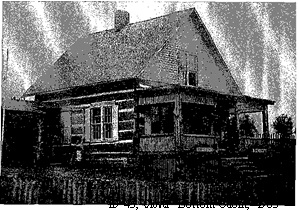Excerpt from Building A College: An Architectural History of Berea College[1]
-------------------------------------------------------------------
Clover Bottom Cabin, 1903
The "Weaving House ...a heartening example of log architecture," was built on the corner of Jackson and Rawlings Street and was the first headquarters for the Berea Fireside Weavers. The poplar logs had once been part of a Baptist Church House at Clover Bottom near the Jackson County line. Hettie Wright Graham, from Flushing, New York, who was in charge of the Berea "Weaving Industry-the wheel, dye kettle and loom" was the first to live in the twenty-six by-twenty-eight feet structure. A multi-windowed shed was connected to the cabin to be used as a loom room. An additional log house which once housed Berea teachers and said to be a hundred years old, was moved near by and it too held looms and spinning wheels ( Berea Quarterly, April, 1904, 5-7). Mrs. Graham was not only supervisor of women student weavers, she was also in charge of purchasing and sales: "For the benefit of those intending to compete for the prizes offered by Berea College for the best dyeing, Mrs. Graham will have for sale at Clover Bottom Cabin on Jackson Street, indigo and madder. These dyes are the best to be found on the market and require less work than inferior ones usually sold in stores. Prices for East India indigo are 15 cents an ounce and Dutch madder, one cent an ounce" ( Berea Citizen, May 29, 1902). Mrs. Graham also bought black fleece for spinning and weaving (BCABG, 5.39). It was she who selected the traditional weaving patterns ("Missouri Trouble", "Young Man's Fancy", "Federal City", "Dogwood Blossom", "Chariot Wheels", etc.) and established a standard of workmanship for the weavers. The cottage was rebuilt and baths were installed to make the structure better suited for residency (PCM, February 12, 1913). To improve the cabin's aesthetics, some architectural details were incorporated in the exterior design; the porch was supported by unturned rustic cedar posts and "gingerbread' brackets were added at the roof soffits. During the most recent years, the former College Dentist has lived in the house.
------------------------------------------------------------
[1] Citation: Boyce, Robert Piper. Building A College: An Architectural History of Berea College. Self-published. Berea, Ky: Berea College Printing Services, 2006, p45.
NOTE: This content is reproduced here with permission of the author and is COPYRIGHT PROTECTED. Fair Use access granted for educational purposes only, therefore, this content may be used in the classroom or classroom assignments without prior permission as long as proper citation is provided. For commercial use, publication, or reproduction, permission must be obtained from copyright holder or owner.

